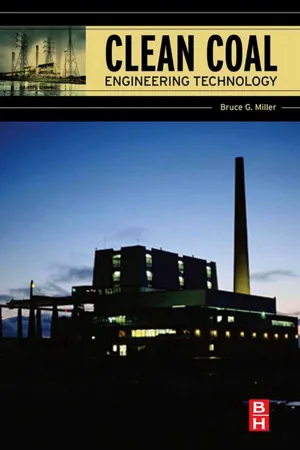
- 696 pages
- English
- ePUB (mobile friendly)
- Available on iOS & Android
Clean Coal Engineering Technology
About this book
Concern over the effects of airborne pollution, green house gases, and the impact of global warming has become a worldwide issue that transcends international boundaries, politics, and social responsibility. The 2nd Edition of Coal Energy Systems: Clean Coal Technology describes a new generation of energy processes that sharply reduce air emissions and other pollutants from coal-burning power plants.Coal is the dirtiest of all fossil fuels. When burned, it produces emissions that contribute to global warming, create acid rain, and pollute water. With all of the interest and research surrounding nuclear energy, hydropower, and biofuels, many think that coal is finally on its way out. However, coal generates half of the electricity in the United States and throughout the world today. It will likely continue to do so as long as it's cheap and plentiful [Source: Energy Information Administration]. Coal provides stability in price and availability, will continue to be a major source of electricity generation, will be the major source of hydrogen for the coming hydrogen economy, and has the potential to become an important source of liquid fuels. Conservation and renewable/sustainable energy are important in the overall energy picture, but will play a lesser role in helping us satisfy our energy demands today. Dramatically updated to meet the needs of an ever changing energy market, Coal Energy Systems, 2nd Edition is a single source covering policy and the engineering involved in implementing that policy. The book addresses many coal-related subjects of interest ranging from the chemistry of coal and the future engineering anatomy of a coal fired plant to the cutting edge clean coal technologies being researched and utilized today. A 50% update over the first edition, this new book contains new chapters on processes such as CO2 capture and sequestration, Integrated Gasification Combined Cycle (IGCC) systems, Pulverized-Coal Power Plants and Carbon Emission Trading.Existing materials on worldwide coal distribution and quantities, technical and policy issues regarding the use of coal, technologies used and under development for utilizing coal to produce heat, electricity, and chemicals with low environmental impact, vision for utilizing coal well into the 21st century, and the security coal presents.- Clean Liquids and Gaseous Fuels from Coal for Electric Power- Integrated Gasification Combined Cycle (IGCC) systems- Pulverized-Coal Power Plants- Advanced Coal-Based Power Plants- Fluidized-Bed Combustion Technology- CO2 capture and sequestration
Frequently asked questions
- Essential is ideal for learners and professionals who enjoy exploring a wide range of subjects. Access the Essential Library with 800,000+ trusted titles and best-sellers across business, personal growth, and the humanities. Includes unlimited reading time and Standard Read Aloud voice.
- Complete: Perfect for advanced learners and researchers needing full, unrestricted access. Unlock 1.4M+ books across hundreds of subjects, including academic and specialized titles. The Complete Plan also includes advanced features like Premium Read Aloud and Research Assistant.
Please note we cannot support devices running on iOS 13 and Android 7 or earlier. Learn more about using the app.
Information
Table of contents
- Cover
- Title Page
- Copyright
- Dedication
- Table of Contents
- Preface
- Chpater 1: Coal as Fuel: Past, Present, and Future
- Chpater 2: The Chemical and Physical Characteristics of Coal
- Chpater 3: The Worldwide Distribution of Coal
- Chpater 4: The Effect of Coal Usage on Human Health and the Environment
- Chpater 5: Introduction to Coal Utilization Technologies
- Chpater 6: Anatomy of a Coal-Fired Power Plant
- Chpater 7: Clean Coal Technologies for Advanced Power Generation
- Chpater 8: Coal-Fired Emissions and Legislative Action
- Chpater 9: Emissions Control Strategies for Power Plants
- Chpater 10: CO2 Capture and Storage
- Chpater 11: U.S. and International Activities for Near-Zero Emissions during Electricity Generation
- Chpater 12: Coal and Energy Security
- Appendix A: Regional Definitions
- Appendix B: Commercial Gasification Facilities Worldwide
- Appendix C: Coal-Fired Emission Factors
- Appendix D: Original List of Hazardous Air Pollutants
- Appendix E: Initial 263 Units Identified in Phase I (SO2) of the Acid Rain Program
- Index